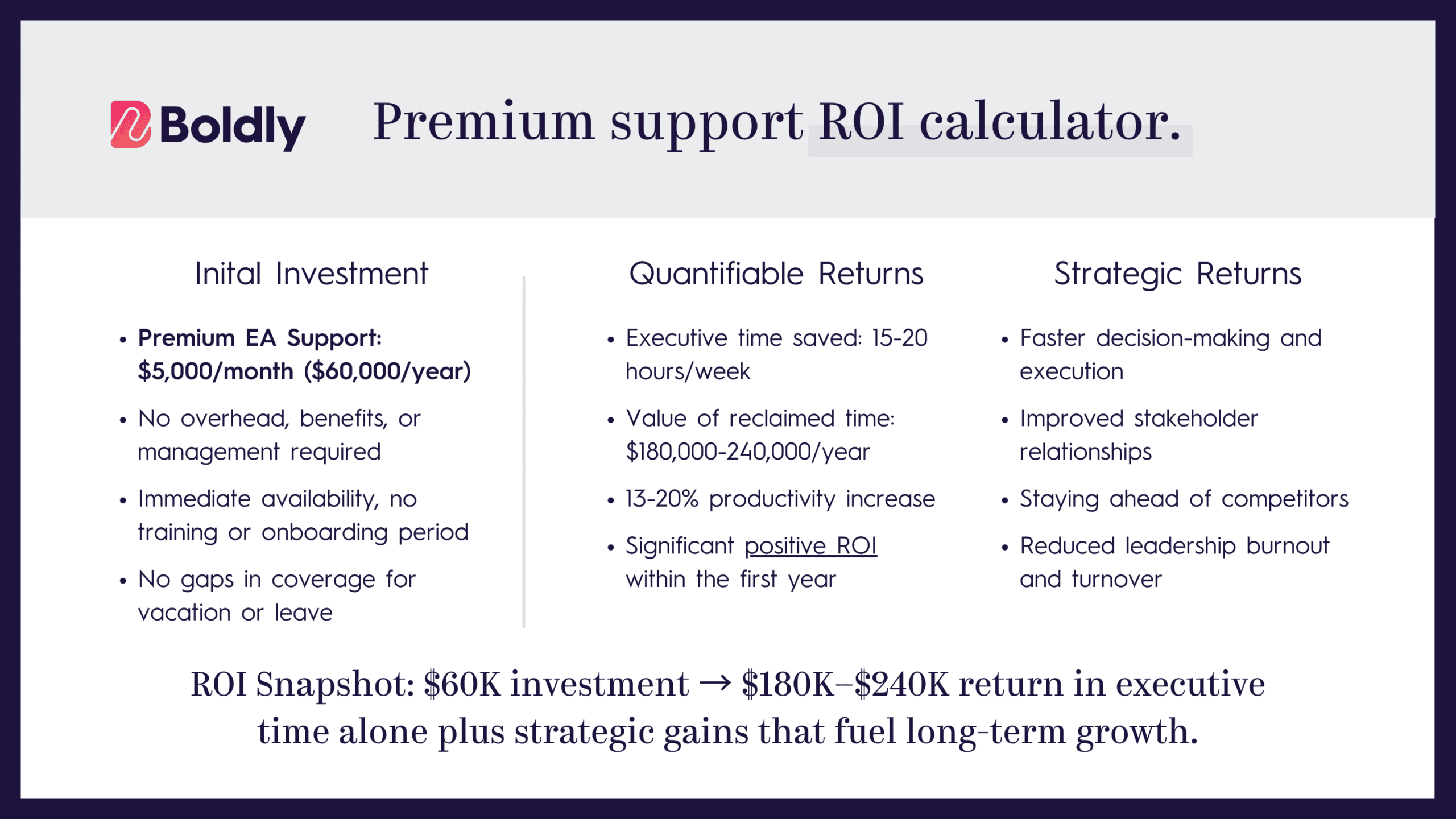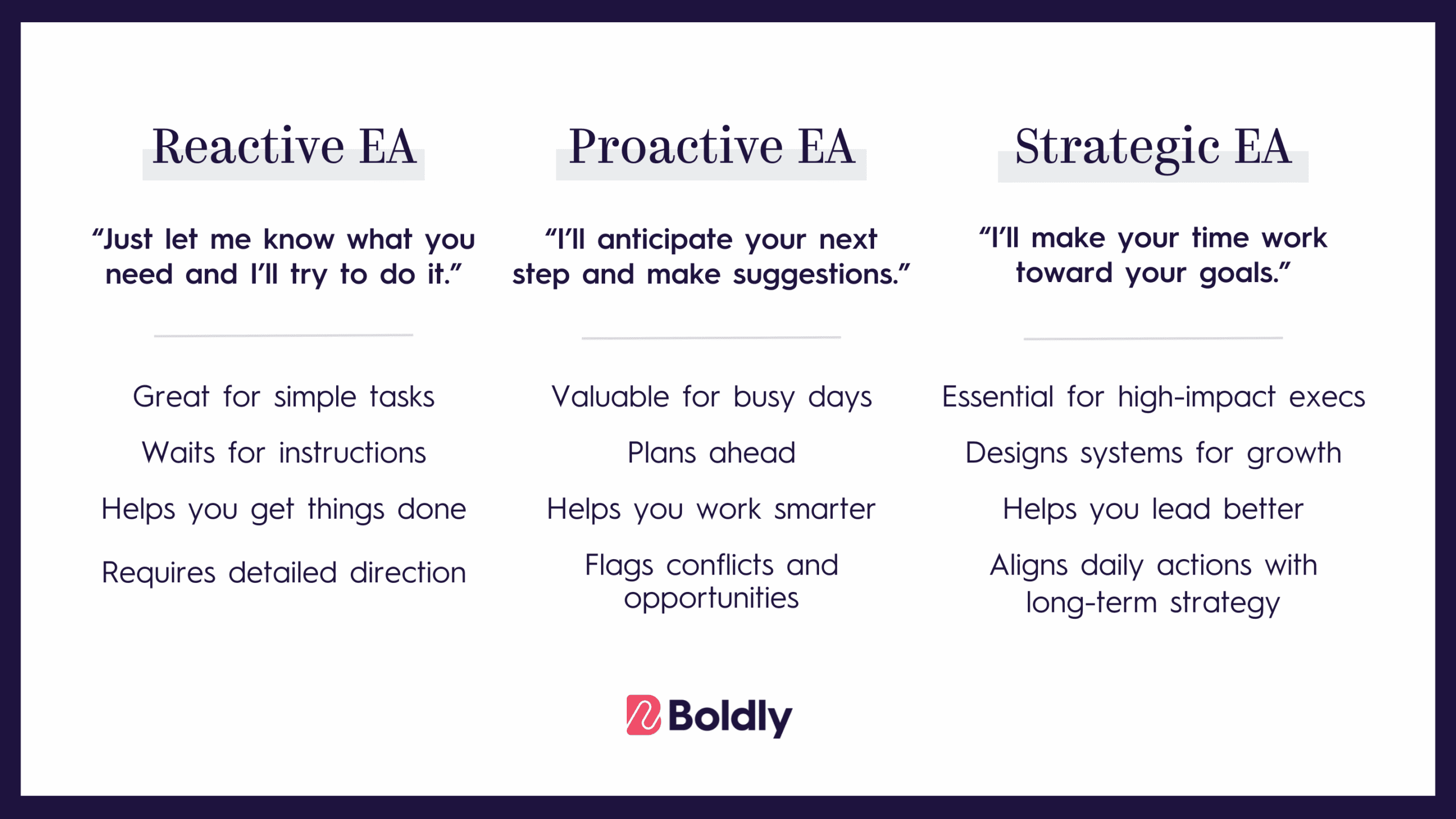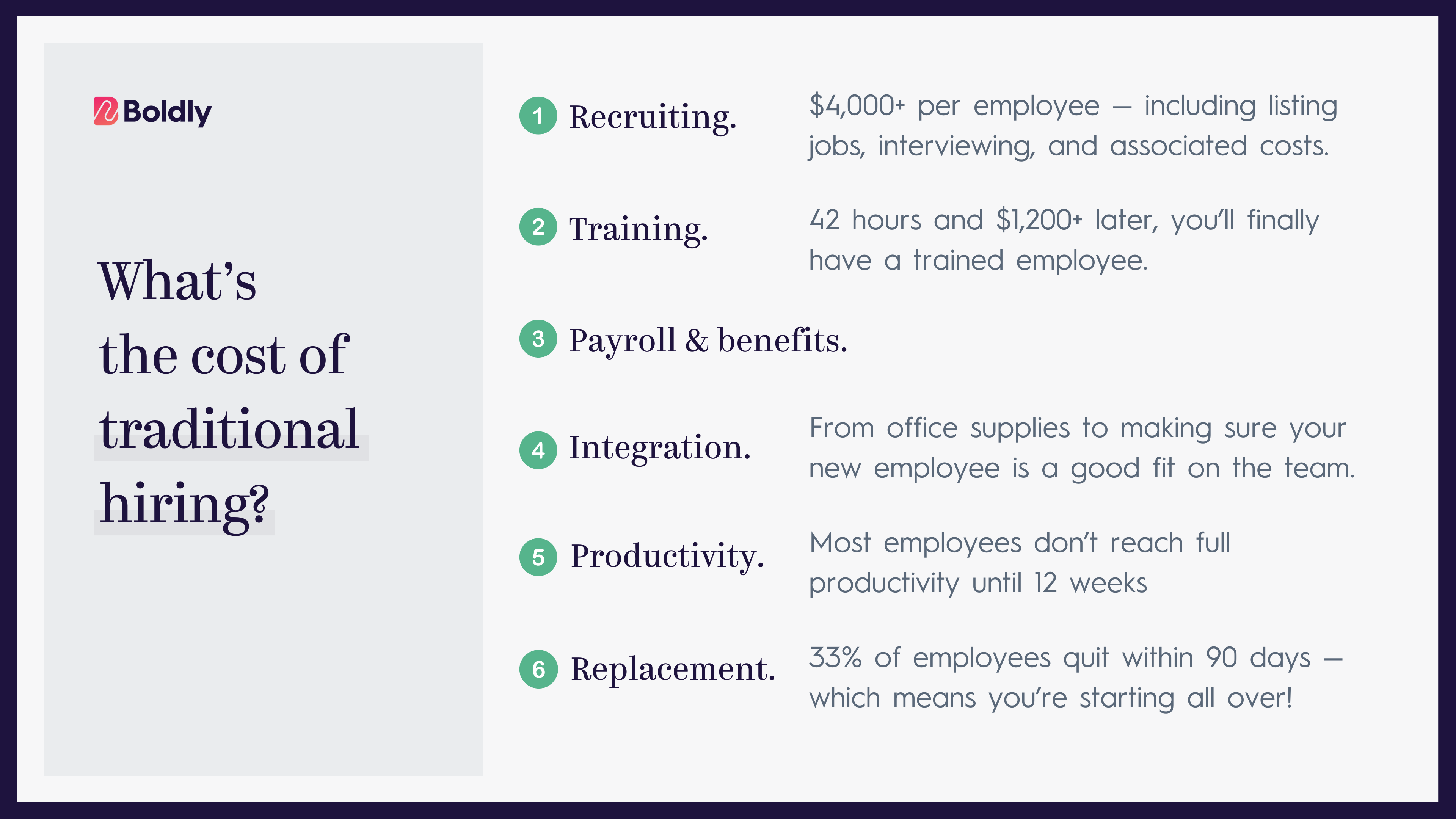The best business cases don’t start with what you want to buy. They start with what it’s costing you not to buy in.
Right now, your executives are spending hours each week on administrative work like calendar management, travel booking, expense reports, and inbox triage.
That’s not just lost time. It’s lost revenue, delayed decisions, and strategic opportunities slipping away.
In today’s economy, with budgets under scrutiny, that’s a cost you can’t afford.
Whether you’re a Chief of Staff, operations director, talent manager, or HR leader, this guide will help you make the case for premium executive assistant support to your C-suite. We’ll show you how to translate time savings into dollars, address the “why not hire in-house?” question, and present a business case that speaks the language of ROI and competitive advantage.
The opportunity is clear: Executive assistants save up to 20% of a CEO’s time, one full day per week that could be redirected to revenue-generating activities. As Stu Loeser, founder of Loeser & Co., shared after working with his Boldly executive assistant: “I was able to increase my productivity easily by 15–20%.”
Here’s your roadmap to building a case that gets approved:
- Start with the cost of the status quo
- Build your case for ROI (we’ll walk you through this)
- Be ready for common objections like “why premium?” and “can’t we hire in-house?”
- Present a phased approach
Start With The Real Cost Of The Status Quo
Before you can make the case for premium support, you need to quantify what the current situation is costing your organization. It’s probably more than you or your leadership realize.


What You’re Seeing Now
- Executives handling their own calendars and drowning in email
- Strategic meetings postponed because of scheduling conflicts
- Leaders working evenings and weekends on administrative tasks
- High-value decisions delayed by operational overwhelm
The Real Business Impact:
- Five to six figures annually in lost productivity per executive
- 70% of C-suite leaders considering leaving due to poor work-life balance
- Countless missed opportunities while leaders manage minutiae
Before discussing the investment in premium support, calculate what the current situation actually costs your organization.
Research shows CEOs spend nearly 24% of their time on emails and administrative tasks — time that should be focused on strategy and growth.
Even when everything seems to be running smoothly, hidden costs are draining executive capacity and slowing growth.
- Lost Executive Time – If your CEO makes $500,000 annually, every hour is worth approximately $240. Spending 10 hours weekly on administrative tasks = $124,800 per year in wasted executive hours. Multiply this across your entire C-suite, and the numbers become staggering.
- Missed Opportunities – Strategic initiatives can be delayed because executives are drowning in operational details. Key relationships get neglected due to calendar conflicts and email overload, and market opportunities are lost while leaders handle tasks beneath their pay grade.
- Burnout and Turnover Risk – The cost of replacing a senior executive can reach 200-400% of their annual salary. Organizational disruption from leadership changes impacts everything from culture to stock price.
When you frame it this way, the question isn’t whether you can afford premium executive support. It’s whether you can afford not to have it.
Speak The Language Of Return On Investment And Strategic Value
Decision-makers need hard numbers and clear value propositions. Here’s how to present the investment case in terms they’ll appreciate.


It’s easy to think of executive support as a cost, but the numbers tell a different story. A high-level executive assistant doesn’t just save time; they create measurable ROI and fuel long-term strategic growth.
Here’s how the investment pays off, assuming an average Boldly plan of 80 hrs/month and an executive salary of $500,000/yr.
Initial Investment:
- Premium EA Support: $5,000/month ($60,000/year)
- No overhead, benefits, or management required
- Immediate availability, no training period
Quantifiable Returns:
- Executive time saved: 15-20 hours/week
- Value of reclaimed time: $180,000-240,000/year
- Productivity increase: 13-20%
- Significant positive ROI within the first year
Strategic Returns (harder to quantify but equally important):
- Faster decision-making and execution
- Improved stakeholder relationships
- Staying ahead of competitors
- Reduced leadership burnout and turnover
The Productivity Multiplier Effect
Stanford University research demonstrated a 13% increase in productivity when workers had proper support structures. For executives, the impact is even greater.
Consider this scenario:
- Your CEO currently spends 15 hours weekly on coordination and administrative tasks
- With premium executive support, that drops to 3 hours
- Those 12 reclaimed hours weekly mean your CEO gains back almost four months of strategic time each year
- At their hourly rate, that’s equivalent to adding 15 weeks of time for strategic work
Quality of Decision-Making
Premium executive assistants don’t just save time. They improve the quality of executive decision-making by:
- Ensuring leaders have complete information before critical meetings
- Handling important relationships before small issues become big problems
- Creating space for strategic thinking instead of reactive problem-solving
Risk Mitigation Value
Premium support also protects your business in ways CEOs care about:
- Keeps you compliant with proper documentation
- Protects confidential information with W2 employees, not contractors
- Provides reliable, consistent support instead of constant turnover
- Prevents expensive mistakes that could harm important relationships
Address The Common Objections Head-On
You know the pushback is coming. Here’s how to address the most common concerns before they derail your proposal. Next, we’ll run through some of the most common things we hear and suggest ways to respond.
“Why do we need premium support?”


Standard Virtual Assistant Capabilities
A standard virtual assistant tends to be reactive. They’re good at completing tasks, but they need constant direction and input. A higher-level VA can become a proactive assistant, but they’re not quite the trusted, strategic partner most executives need.
- Follows detailed instructions
- Manages basic calendar scheduling
- Handles routine email responses
- Completes defined administrative tasks
- Works prescribed hours
- Requires regular supervision
- Typical cost: $15-25/hour
Premium Executive Assistant Capabilities
A premium assistant truly starts to multiply an executive’s time.
- Anticipates needs proactively
- Optimizes entire calendar strategically
- Manages complex key relationships
- Leads projects independently
- Available as situations demand
- Self-directed problem solver
- Investment: $60-80K/year for dedicated support
“Can’t we hire someone in-house for less?”
The true cost comparison isn’t just salary.
Think about this:
- Recruiting costs (typically 20-30% of annual salary)
- Benefits and overhead (add 30-40% to base salary)
- Training and ramp-up time (3-6 months of reduced productivity)
- Management oversight required
- Turnover risk and replacement costs


A premium executive assistant through a service like Boldly costs less than a full-time hire while providing immediate expertise, no overhead, and guaranteed continuity.
“We’re trying to reduce costs, not add them.”
Reframe this as an investment that generates returns, not a cost center:
- Show how much executive time you’ll save in dollar terms
- Project the revenue impact of executives focusing on strategic initiatives
- Factor in the cost savings from improved efficiency and reduced turnover
- Consider the competitive advantage of having fully-supported leadership
When a $50,000 investment in premium support frees up $200,000 worth of executive time for strategic work, it’s not an expense—it’s a 4x return.
Present A Phased Approach To Minimize Risk
Decision-makers appreciate risk mitigation. Propose a pilot program that demonstrates value before full commitment:
Phase 1: Pilot Program (3 months)
- Start with premium support for one or two key executives
- Define specific, measurable success metrics
- Track time saved, projects completed, and satisfaction scores
- Document the impact on strategic initiative progress
Phase 2: Expand Based on Results (Months 4-6)
- Scale support to additional executives based on pilot success
- Refine processes and preferences
- Calculate ROI from the pilot phase
- Build internal champions who’ve experienced the benefits
Phase 3: Full Implementation
- Roll out comprehensive premium support across the leadership team
- Make support part of your business strategy
- Establish long-term partnerships with premium providers
- Continuously optimize based on evolving needs
This approach allows skeptical stakeholders to see proof of concept before making a larger commitment.
Premium Support Is Mission Critical
Making the business case for premium executive support isn’t about asking for a luxury—it’s about advocating for a strategic tool that makes your leaders more effective.
When executives spend their time on what truly matters—strategy, relationships, and growth—the entire organization benefits. The question isn’t whether premium support is worth the investment. It’s whether your organization can afford to keep operating without it.
Your leadership team’s time is your company’s most valuable asset. Premium executive support doesn’t just protect that asset—it gets the most from it.
Ready to build your business case? The data is clear, the ROI is proven, and your executives are waiting for the support they need to truly excel.




